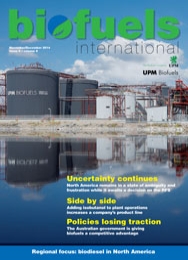
Volume 8, Issue 6
Published: November 10, 2014
On the same page
The renewable fuel industry has had its share of struggles when it comes to planning a confident growth trajectory. Regulatory uncertainty is one of the primary culprits that makes it difficult for renewable...
Out with the old
In recent years, the biofuels industry has experienced a number of intermittent setbacks, including the unpredictability of government subsidies, the emergence of the food versus fuel debate, and the introduction...
Estimated GHG increase from Obama Administration inaction on 2014 RFS
In November 2013, the US Environmental Protection Agency (EPA) proposed waiving a substantial portion of the Renewable Fuel Standard (RFS) mandated volumes for 2014 and reducing the use of biofuels in...
Going ahead
In January 2015, Germany will change the country’s commitment framework from a renewable energybased quota, which currently sits at 6.25% and remains unchanged from 2010, to a greenhouse gas (GHG)...
Current price index
The global commodities markets have been at the centre of a near perfect storm of bearish factors in recent weeks. The strong US dollar coupled with a booming US shale oil output has hit crude oil prices...
Lethargic US biodiesel spot market drops more than 10% in Q3
Soya methyl esters biodiesel spot prices in the US dropped 10.5% or more in the third quarter to fouryear lows despite higher implied demand for distillate fuels. These were pressured by a 10.9% decline...
Side by side
In June this year, renewable chemicals and advanced biofuels company Gevo started the coproduction of isobutanol and ethanol at its existing ethanol plant in Luverne, Minnesota, US. The plant uses three...
Keeping it local
On 1 May this year, small-scale biodiesel producer Springboard Biodiesel opened the doors of its first fully automated, zerowaste biodiesel production facility in Chico, California at a grand opening....
Reinventing the wheel or going round in circles?
Many governments insist on finding new solutions for problems that have already been solved, and in doing so, end up going round in circles. This is happening at present on both sides of the Atlantic,...
Uncertainty continues
The US Environmental Protection Agency (EPA) writes and enforces regulations concerning the environment based on laws made by Congress. Biodiesel is one of the first advanced biofuels to achieve commercial-scale...
Catching up
The US and Europe have long realised the benefits of biofuels, but the Middle East is quickly catching up. For years, the Middle East depended heavily on gulf countries for fuel. This gave the US and Europe...
Name of the game
In 2003, less than three million gallons of ethanol were produced. Today the US has a total installed capacity approaching 15 billion gallons per year; nearly 500% the production of a decade ago. With...
Wanting more
North America is keenly focused on next generation corn oil extraction methods to meet a growing demand for biodiesel feedstock, as well as animal feed supplements. Biodiesel producers, who are currently...
Improving fermentation through optimised mixing design
Aerobic fermentation is becoming an increasingly common application in the production of biofuel from sugars. Although the goals are similar to other fermentation processes, the different feedstock rheology...
From spools to biofuels
Biomass-based production is becoming increasingly important in the Finnish and European bioeconomies. Responsibly produced wood-based biofuels are a worthwhile alternative, reducing traffic emissions and...
Transforming the market
Companies generally pre-treat their feedstocks using sulphuric acid, an acidic polymer-based resin or enzymatic process. Lower grade feedstock does not always improve companies’ bottom line. Yield...
Crowning glory
Most biodiesel is derived from triglycerides or fats, which are purified and reacted with alcohol to create fuel. Producers must decide whether to remove all of these problematic components at the beginning...
Time for a new wave of optimism?
I am sure I once heard that if everyone in China jumped up and down at the same time a small Earth tremor would be felt far across other continents. Well maybe it’s time for everyone in the biofuels...
On the road to success
Although plantbased fuels are renewable, create less combustion damage to the environment and support agricultural development, the biofuels industry needs to avoid conflicts with food crop energy farming....
On the brink of commercialisation
Jatropha may finally be able to shrug off its earlier disappointments as a biofuel crop as scientific progress in the last decade signal light at the end of the tunnel. Breeders have begun to reveal yields...
Reducing water use in dry grind ethanol plants
Similar to many other industries, fuel ethanol producers have focused on water conservation, due to the increasing risks of water scarcity and wastewater disposal limitations to their operations and initiatives...
Accelerating R&D for biofuels and biochemicals
The use of biofuels and biochemicals as alternatives to petroleum-based products has attracted much attention over the last few years. This attractiveness stems from their classification as sustainable...
Breaking new ground
Due to the predicted increase in biodiesel consumption and the ongoing discussion regarding first generation biodiesel processes, technology developer BDI is continuing with the ongoing search for new...
Nitrogen blanketing for biofuel storage
Air is detrimental to many materials. Not only can the oxygen in the air cause product degradation, but moisture, dirt, hydrocarbons and exhaust gases can negatively affect the raw materials stored in...
Pick of the crop
The key to commercial success of solid state fermentations compared to liquid substrates or slurries is improving process efficiency through R&D work, which can be carefully monitored and controlled...
Disruption hits biobutanol production
Bioethanol shares 80 million tonnes annual consumption around the world. However, some of the inherent properties of ethanol, such as high water solubility and low energy density, set the limit of its...
Performance inspired by nature
Despite its relatively short life, the modern biofuels industry has experienced amazing technological and market transformations. We have seen shifting political landscapes, a worldwide financial recession,...
A drop in the engine
With demand for drop-in hydrocarbon fuels growing, the industry is looking to convert a broad range of biomass and organic residues to fungible liquid ‘drop-in’ hydrocarbon fuels fully compatible...
Policies losing traction
Sustainable growth of the Australian biofuel industry has been in reverse since 2011. Over the past four years there have been at least four or five ‘structural’ changes to the support schemes...










